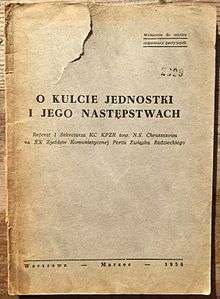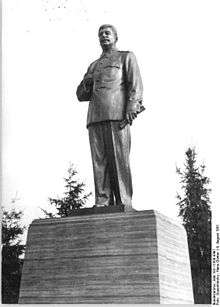De-Stalinization
De-Stalinisation (Russian: десталинизация, destalinizatsiya) consisted of a series of political reforms in the Soviet Union after the death of long-time dictator Joseph Stalin in 1953, and the ascension of Nikita Khrushchev to power.[1]
The reforms consisted of changing or removing key institutions that helped Stalin hold power: the cult of personality that surrounded him, the Stalinist political system, and the Gulag labour-camp system, all of which had been created by Stalin. These reforms were started by the collective leadership which succeeded him after his death in March 1953, consisting of Georgi Malenkov, Premier of the Soviet Union; Lavrentiy Beria, head of the Ministry of the Interior; and Nikita Khrushchev, First Secretary of the Central Committee of the Communist Party of the Soviet Union (CPSU).
Terminology issues
The term "de-Stalinisation" is one which gained currency in both Russia and the Western world following the collapse of the Soviet Union, but was never used during the Khrushchev era. However, de-Stalinisation efforts were set forth at this time by Nikita Khrushchev and the Government of the Soviet Union under the guise of the "overcoming/exposure of the cult of personality", with a heavy criticism of Joseph Stalin's "era of the cult of personality".[2] However, prior to Khrushchev's "Secret Speech" to the 20th Party Congress, no direct association between Stalin as a person and "the cult of personality" was openly made by Khrushchev or others within the party, although archival documents show that strong criticism of Stalin and his ideology featured in private discussions by Khruschchev at the Presidium of the Supreme Soviet.[2]
"Silent de-Stalinisation"
There were dangers in denouncing Stalin as he was placed on a pedestal both at home and among communists abroad.[3] In the years 1953–1955, a period of "silent de-Stalinization" took place, as the revision of Stalin's policies was done in secret, and often with no explanation. This period saw a number of non-publicised political rehabilitations,[4] by way of persons and groups such as Marshal Mikhail Tukhachevsky, Politburo members Robert Eikhe and Jānis Rudzutaks, those executed in the Leningrad Affair[5], and the release of "Article 58ers".[4] However, due to the huge influx of prisoners returning from the camps (90,000 prisoners in 1954–55 alone), this could not continue.[4]
In December 1955 Khrushchev proposed that a commission be set up in order to investigate Stalin's activities on behalf of the Presidium. This investigation determined that out of the 1,920,635 arrested for anti-Soviet activities – who were often arrested on fabricated evidence in the first place and confessed under torture authorised by Stalin – 688,503 were executed - 35.8%.[6]
Khrushchev's "Secret Speech"

De-Stalinisation meant an end to the role of large-scale forced labor in the economy. The process of freeing Gulag prisoners was started by Lavrentiy Beria. He was soon removed from power, arrested on 26 June 1953, and executed on 24 December 1953. Nikita Khrushchev emerged as the most powerful Soviet politician.[7]
While de-Stalinisation had been quietly underway ever since Stalin's death, the watershed event was Khrushchev's speech entitled "On the Cult of Personality and Its Consequences", concerning Stalin. On 25 February 1956, he spoke to a closed session of the 20th Party Congress of the Communist Party of the Soviet Union, delivering an address laying out some of Stalin's crimes and the "conditions of insecurity, fear, and even desperation" created by Stalin.[1] Khrushchev shocked his listeners by denouncing Stalin's dictatorial rule and his cult of personality as inconsistent with communist and Party ideology. Among other points, he condemned the treatment of the Old Bolsheviks, people who had supported communism before the revolution, many of whom Stalin had executed as traitors. Khrushchev also attacked the crimes committed by associates of Beria.
Motivation
One reason given for Khrushchev's speech was his moral conscience; Aleksandr Solzhenitsyn said that Khrushchev spoke out of a "movement of the heart". This, the Communists believed, would prevent a fatal loss of self-belief and restore unity within the Party.[8]
Martin McCauley argues that Khrushchev's purpose was to "liberate Party officials from the fear of repression". Khrushchev argued that if the Party were to be an efficient mechanism, stripped from the brutal abuse of power by any individual, it could transform the Soviet Union as well as the entire world.[9]
However, others have suggested that the speech was made in order to deflect blame from the Communist Party or the principles of Marxism–Leninism and place the blame squarely on Stalin's shoulders, thus preventing a more radical debate.[8] However, the publication of this speech caused many party members to resign in protest, both abroad and within the Soviet Union.[8][5]
By attacking Stalin, McCauley argues, he was undermining the credibility of Molotov, Malenkov, Kaganovich and other political opponents who had been within "Stalin's inner circle" during the 1930s more than he had been. If they did not "come over to Khrushchev", they "risk[ed] being banished with Stalin" and associated with his dictatorial control.[9]
Changes
Prisons
The amnesty decree of March 1953 began the release of most prisoners.[10] Former political prisoners often faced ingrained hostility upon their return, which made it difficult to reintegrate into normal life.[11] On 25 October 1956, a resolution of the CPSU declared that the existence of the Gulag labour system was "inexpedient".[12] The Gulag institution was closed by the Ministry of Internal Affairs (MVD) order No 020 of 25 January 1960.[13]
For those who remained, Khrushchev attempted to make the Gulag labour system less harsh, by allowing prisoners to post letters home to their families, and by allowing family members to mail clothes to prisoners, which was not allowed under Stalin.[14]
Re-naming of places and buildings
Khrushchev renamed or reverted the names of many places bearing Stalin's name, including cities, territories, landmarks, and other facilities.[15] The State Anthem of the Soviet Union was purged of references to Stalin, and so were the anthems of its republics. The Stalin-centric and World War II-era lines in the lyrics were effectively excised when an instrumental version replaced it. The Joseph Stalin Palace of Culture and Science in Warsaw, Poland was renamed in 1956. Stalin Peak, the highest point in the USSR, was renamed Communism Peak. After the collapse of the USSR, the mountain was renamed Ismoil Somoni Peak.
Destruction of monuments

The Yerevan monument was removed in spring 1962 and replaced by Mother Armenia in 1967. Thousands of Stalin monuments have been destroyed not only in the Soviet Union, but in other former Communist countries as well. In November 1961, the large Stalin Statue on Berlin's monumental Stalinallee (promptly renamed Karl-Marx-Allee) was removed in a clandestine operation. The Monument in Budapest was destroyed in October 1956. The biggest one, the Prague monument, was taken down in November 1962.
Re-location of Stalin's body
Given momentum by these public re-namings, the process of de-Stalinisation peaked in 1961 during the 22nd Congress of the CPSU. Two climactic acts of de-Stalinisation marked the meetings: first, on 31 October 1961, Stalin's body was moved from Lenin's Mausoleum in Red Square to a location near the Kremlin wall;[16] second, on 11 November 1961, the "hero city" Stalingrad was renamed Volgograd.[17]
Foreign policy changes after Stalin
The Stalin era ended with the appointment of Nikita Khrushchev, who defined Soviet foreign policy after Stalin and entering into the Cold War. The biggest change to foreign policy dealt with "uncommitted nations". There were two types of neutrality according to the Soviets, those by ideology and those by circumstance.[18] Many of the nations that were neutral came from both of these groups and were former colonies of European powers. During Stalin there was no room for neutral countries and the idea of neutral powers came about under Khrushchev.[18] Khrushchev's biggest contribution to foreign policy is taking advantage of other aspects of de-Stalinisation to try and show the world a different Soviet Union more in line with traditional socialist ideals.[19]
Extent of de-Stalinisation
Contemporary historians regard the beginning of de-Stalinisation as a turning point in the history of the Soviet Union that began during the Khrushchev Thaw. It subsided during the Brezhnev period until the mid-1980s, and accelerated again with the policies of perestroika and glasnost under Mikhail Gorbachev.
De-Stalinisation has been considered a fragile process. Historian Polly Jones said that "re-Stalinisation" was highly likely after a brief period of "thaw".[2] Anne Applebaum agrees: "The era which came to be called the 'Thaw' was indeed an era of change, but change of a particular kind: reforms took two steps forward, and then one step—or sometimes three steps—back."[20]
See also
- History of the Soviet Union (1953–1964): de-Stalinsation and the Khrushchev era
- List of places named after Joseph Stalin
- Decommunization
References
- Hunt, Michael H. (2015-06-26). The world transformed: 1945 to the present. p. 153. ISBN 978-0-19-937102-0. OCLC 907585907.
- Polly Jones (7 April 2006). The Dilemmas of De-Stalinization: Negotiating Cultural and Social Change in the Khrushchev Era. Routledge. pp. 2–4. ISBN 978-1-134-28347-7.
- National Republic. 44–45. 1956. p. 9.
- Nanci Adler (1 February 2004). The Gulag Survivor: Beyond the Soviet System. Transaction Publishers. pp. 21–22. ISBN 978-1-4128-3712-5.
- Kees Boterbloem (28 August 2013). A History of Russia and Its Empire: From Mikhail Romanov to Vladimir Putin. Rowman & Littlefield Publishers. p. 261. ISBN 978-0-7425-6840-2.
- Eric G. Swedin (2010). When Angels Wept: A What-If History of the Cuban Missile Crisis. Potomac Books, Inc. p. 75. ISBN 978-1-59797-565-0.
- "soviethistory.org". Archived from the original on 2014-03-30. Retrieved 2013-12-26.
- Cavendish, Richard (2 February 2006). "Stalin Denounced by Nikita Khrushchev". History Today. 56 (2). Retrieved 11 March 2017.
- Martin McCauley (9 September 2014). The Khrushchev Era 1953–1964. Routledge. pp. 43–44. ISBN 978-1-317-88922-9.
- "Gulag: Soviet Forced Labor Camps and the Struggle for Freedom". Gulaghistory.org. Retrieved 2013-10-12.
- Nanci Adler, The Gulag Survivor: Beyond the Soviet System (2002)
- Memorial http://www.memo.ru/history/nkvd/gulag/Articles/chapter3main.htm
- Memorial http://www.memo.ru/history/NKVD/GULAG/r1/r1-4.htm
- "Gulag : Soviet Prison Camps and their Legacy" (PDF). Gulaghistory.org. Retrieved 2013-10-12.
- G. R. F. Bursa (1985). "Political Changes of Names of Soviet Towns". Slavonic and East European Review. 63.
- "CNN Interactive – Almanac – October 31". CNN.
(October 31) 1961, Russia's de-Stalinisation program reached a climax when his body was removed from the mausoleum in Red Square and re-buried.
Cite journal requires|journal=(help) - "Stalingrad Name Changed". The New York Times. Reuters. 1961-11-11.
MOSCOW, Saturday, Nov. 11 (Reuters) -- The "Hero City" of Stalingrad has been renamed Volgograd, the Soviet Communist party newspaper Pravda reported today.
- Dallin, David (1961). Soviet Foreign Policy After Stalin. New York: J. B. Lippincott Company. p. 286.
- Barghoorn, Frederick C. (1956). "De-Stalinization : Temporary Tactic or Long Term Trend?". International Journal. 12 (1): 24–33. doi:10.2307/40198288. JSTOR 40198288.
- Applebaum, Anne (2003). "Thaw – and Release". Gulag: A History. Doubleday. ISBN 978-0-7679-0056-0.
Further reading
- Dobson, Miriam. "The post-Stalin era: de-Stalinization, daily life, and dissent." Kritika: Explorations in Russian and Eurasian History 12.4 (2011): 905–924. online
- Filtzer, Donald. Soviet Workers and De-Stalinization: The Consolidation of the Modern System of Soviet Production Relations 1953-1964 ( Cambridge UP, 2002).
- Jones, Polly, ed. The dilemmas of de-Stalinization: negotiating cultural and social change in the Khrushchev era (2006).
- McClarnand, Elaine. "The Politics of History and Historical Revisionism: De-Stalinization and the Search for Identity in Gorbachev's Russia, 1985-1991." History Teacher 31.2 (1998): 153–179. online
- Mëhilli, Elidor. "Defying de-stalinization: Albania's 1956." Journal of Cold War Studies 13.4 (2011): 4-56. online
